Introduction
- Male circumcision (MC) – excision of penile prepuce (Morris & Kriegler, 2017).
- Often performed in infants for therapeutic, prophylactic, or religious reasons.
- MC without local anesthetics:
- Sensitivity to pain (Morris, 2016).
- Ethical issues
- Risks >health benefits.
- ‘Do no harm’ principle – normal genitalia.
- Proposed thesis:
- MC without anesthetics lacks medical & ethical justification.
Male circumcision (MC) is the complete or partial excision of the penile prepuce or foreskin for religious, therapeutic, or prophylactic reasons (Morris & Kriegler, 2017). MC without analgesics is premised on lower pain scores at the neonatal stage (Morris, 2016). However, the practice raises significant ethical issues related to pain sensation, health risks, etc. The position taken in this presentation is that MC without anesthetics has no medical or ethical justification.
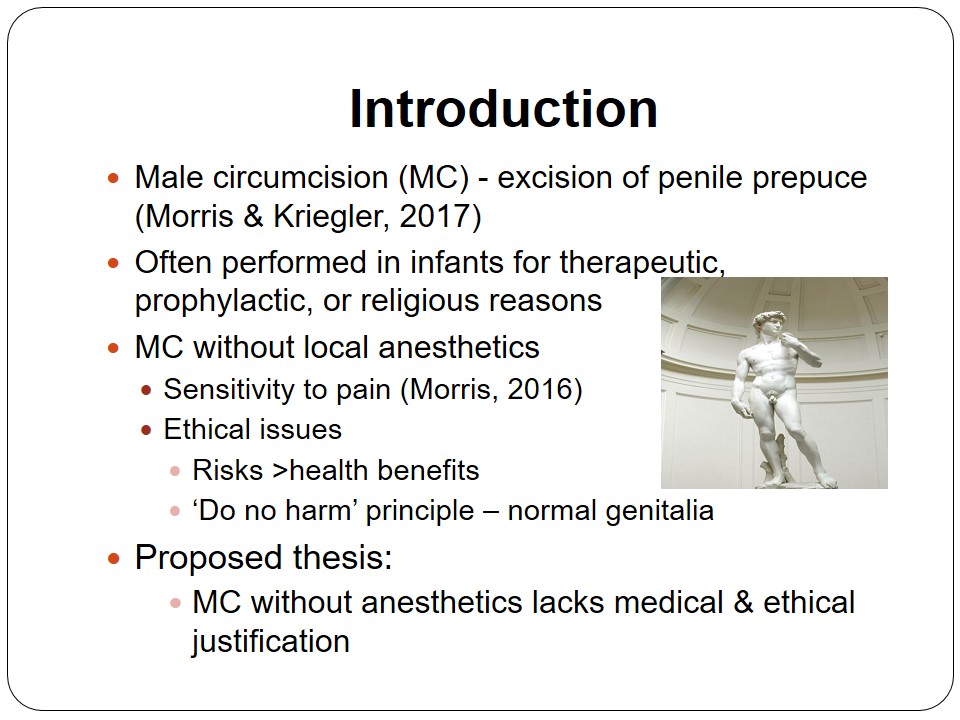
Ethical Approach: Utilitarianism
- A morally acceptable action has the greatest happiness (Mondal, Ponnambath, & Parija, 2016).
- Happiness is when pleasure > pain felt.
- Procedures should be pain free – no harmful contact.
- Optimal pleasure or safety at minimal surgical risk.
- Therefore, maximum utility is obtained by avoiding pain/suffering.
Utilitarianism theory holds that an action considered moral or ethically acceptable is the one guaranteeing the greatest amount of happiness/pleasure (Mondal, Ponnambath, & Parija, 2016). Thus, the benefits of the procedure must be weighed against its risks. It must bring greater happiness than pain or suffering to the subject. The maximum utility of a surgical procedure may be realized by alleviating pain and suffering through pharmacological or non-pharmacological interventions.
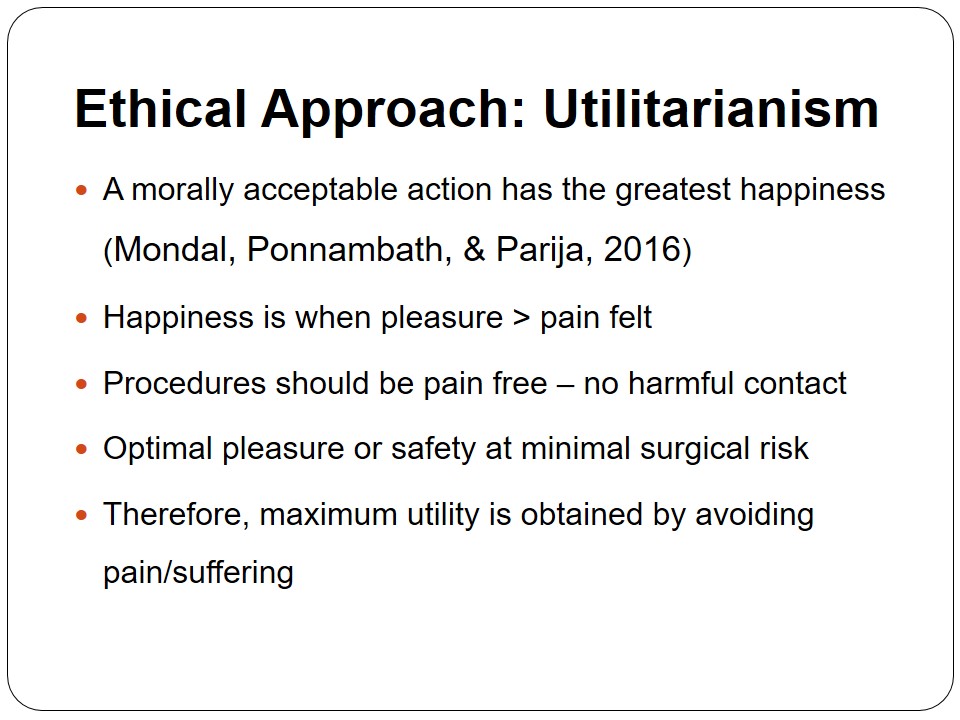
Utilitarianism Applied to MC
- Maximum utility – pain free procedure.
- Minimize pain/trauma to guarantee greatest happiness.
- MC without anesthetics – negative welfare impact.
- Violates ethical principles, including:
- Beneficence – unlikely to do good, i.e., no medical justification (Mondal et al., 2016).
- Non-maleficence – inflicts harm/pain.
- Benefits do not exceed risks/losses.
For MC without pain relief, the pain/trauma experienced, ethical violations, and possible complications arguably outweigh its benefits. Maximum utility cannot be realized since the procedure inflicts pain/trauma. The absence of pain relief medication means that the procedure has a negative impact on the welfare/happiness of the subject. It also violates the basic ethical principles of beneficence and non-maleficence.
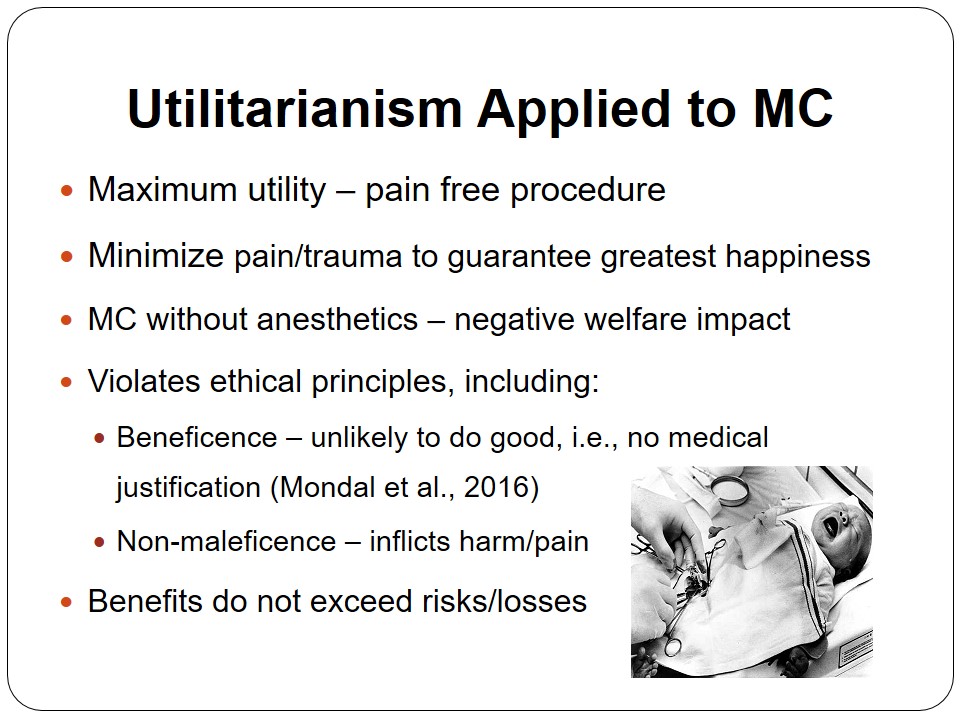
Pro View of MC without Anesthetics
- Lowers the risk of STIs – HIV, genital herpes & warts, syphilis (Morris, Krieger, & Klausner, 2017); but requires condom use.
- Minimizes penile cancer risk in old age (Svoboda & Van Howe, 2013).
- Reduces incidence of UTIs (Simforoosh et al., 2012).
- Reduced risk of phimosis & balanitis (Morris & Krieger, 2017).
- Lowers Trichomoniasis & cervical cancer risk in female partners; however, evidence is limited (CDC, 2014).
- Cardinal medical question: MC prevents disease, but is avoiding anesthetics justifiable?
MC has multiple health benefits for men and their female partners. Studies show that MC reduces the risk of STIs, including genital warts and HIV. MC offers a significant protection from HIV infection in men. However, condom use is a safer method. According to Tobian, Kacker, and Quinn (2013), neonatal MC lowers the risk of UTIs, penile cancer, and penile inflammatory infections – phimosis and balanitis – and has indirect health benefits, including reduced risk of bacterial vaginosis, trichomoniasis, and cervical cancer due to HPV free glans. However, the evidence is weak. Further, MC without anesthetics raises a pertinent medical question; does the nonuse of local anesthetics improve the health outcomes in terms of disease preventions compared to the use of painkillers?
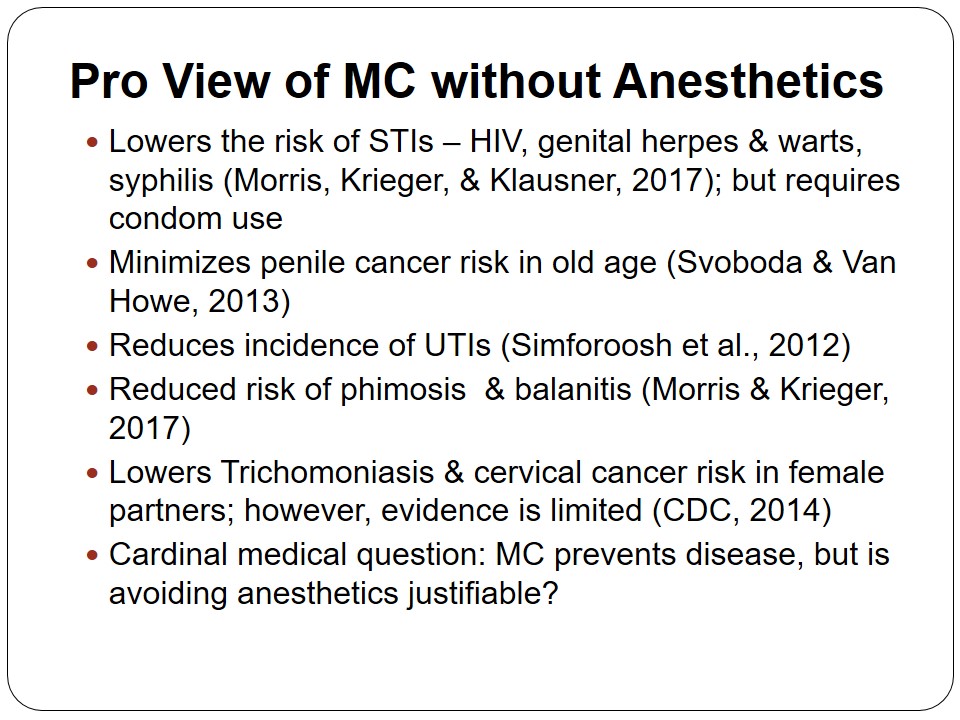
Con View of MC without Anesthetics
- First, do no harm – performed without anesthetics.
- Painful, irreversible, inessential & invasive.
- Performed without a therapeutic reason on a non-consenting child.
- Regrets in adults (Alkhenizan & Elabd, 2016).
- Loss of function:
- MC removes sensitive penile parts.
- Orgasm difficulties.
- Conclusion: MC without anesthetics conflicts medical ethics.
MC performed without anesthetics is in conflict with the ethical principle of ‘first, do no harm’. It raises two ethical questions; first, is it moral to change a male child’s natural genitalia when there is no medical justification? Second, is it appropriate to perform a painful, non-therapeutic, and irreversible procedure on a non-consenting child? The answer to both questions is no. MC also causes loss of function, regrets in adulthood, and other complications.
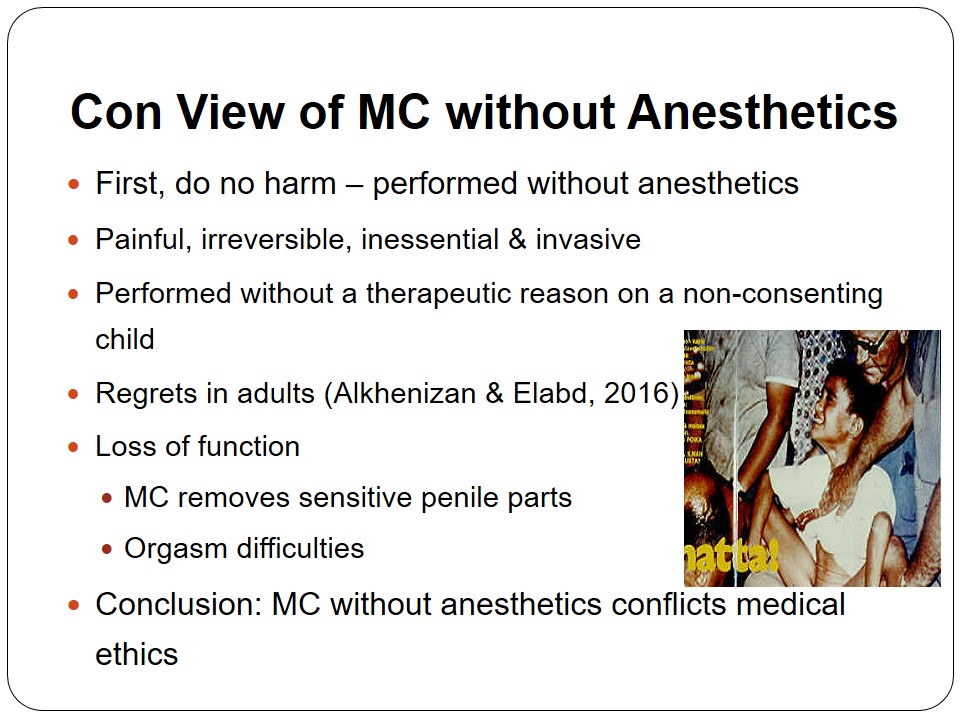
Strategies to Prevent/Minimize Conflict
- Conflict with ethics could be minimized through a competent use of local anesthetics:
- Non-maleficence principle – alleviate pain/trauma.
- Avoid non-therapeutic MC.
- Valid parental consent:
- Unmask likely risks.
- Postpone MC until adulthood:
- >18 years.
- Benefits must outweigh risks – ethical principle of beneficence.
MC conflicts with ethical principles. One strategy for preventing or minimizing this conflict is through a competent use of anesthetics in line with the principle of non-maleficence. Further, the procedure should be performed when a medical need exists. Valid parental consent can also minimize this conflict. The procedure could also be postponed until the child is old enough to decide. Finally, the benefits to the child must outweigh the risks in line with the principle of beneficence.
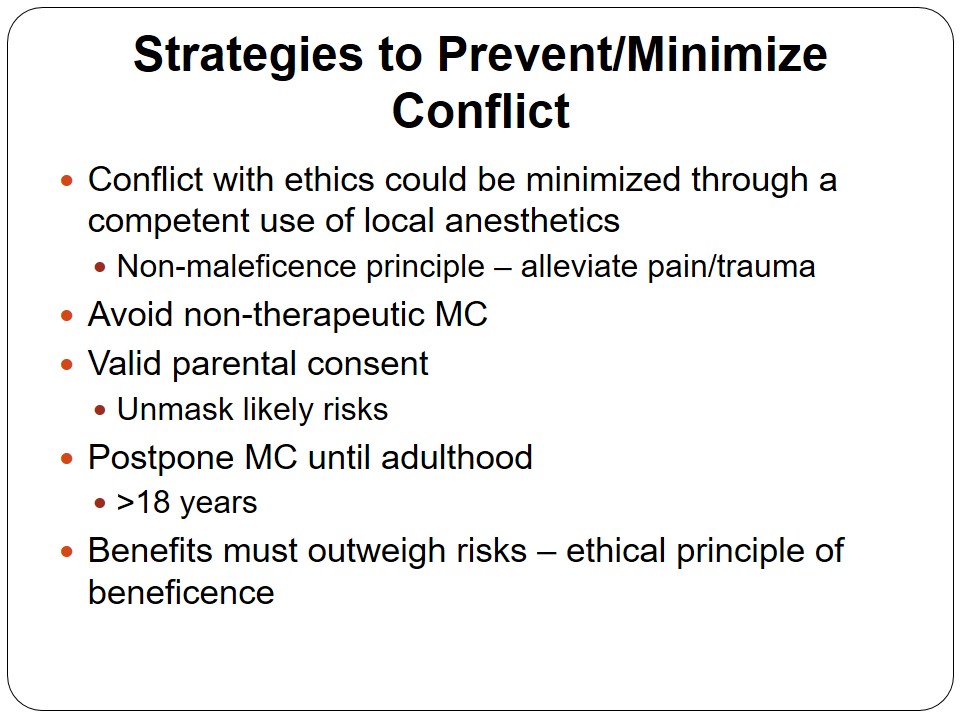
Strategies in Case of Conflict
- Informed, voluntary consent by adults:
- No ethical conflict when MC involves adult consent.
- Use conservative, pain free interventions:
- Dorsal nerve block – reduces post-operative pain (Bellieni, Alagna, & Buonocore, 2013).
- Mogen surgical procedure.
- Explain complications or contraindications.
- Use analogous procedures.
- Rites of passage – cultural MC.
Evidently, MC without anesthetics violates medical ethics. This conflict can be resolved through strategies like obtaining informed consent from adults, implying that MC should be done in adult males. Another strategy would involve alternative, less painful procedures that entail the administration of local analgesics, e.g., dorsal nerve block (Bellieni, Alagna, & Buonocore, 2013). Potential complications should also be made clear to the male adult. For cultural MC, alternative rites of passage could be used in place of painful MC.
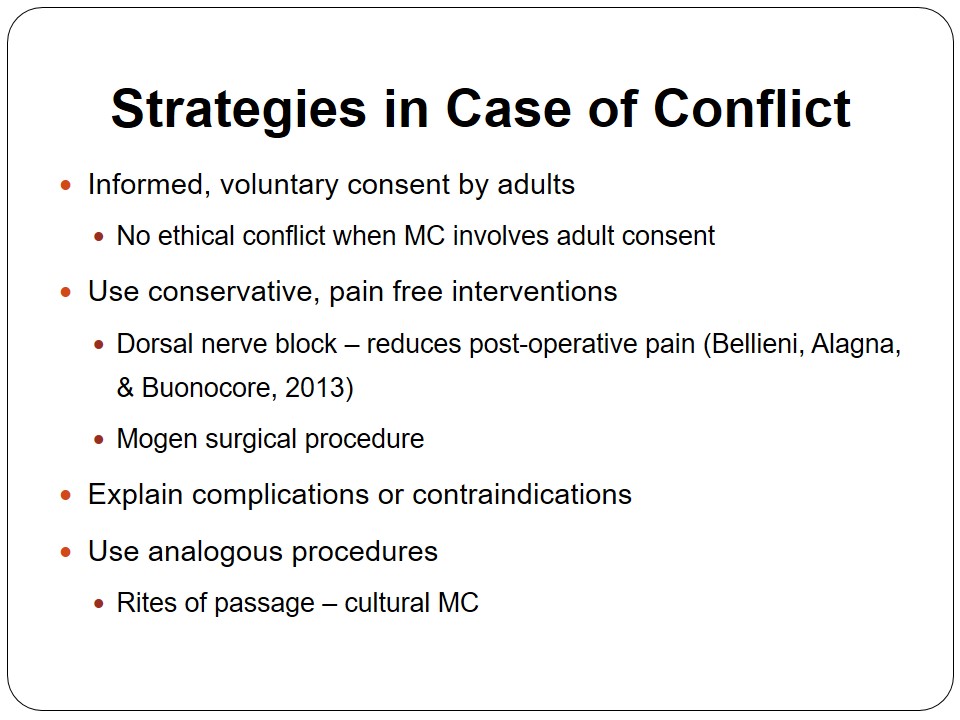
Ethical Dilemma in Nursing
- Patient autonomy vs. nurse control.
- A patient may refuse medical advice:
- Less optimal outcomes for hospitals.
- Autonomy vs. non-maleficence:
- Respect individual right to make decisions vs. do no harm.
- Autonomy helps protect:
- Freedom;
- Privacy;
- Self-determination;
- Individual decisions about one’s body (Earp, 2015).
One important ethical dilemma in nursing is how to balance patient autonomy and nurse control. A patient may reject life-saving interventions or procedures, resulting in poor outcomes for the healthcare organization. While the ethical principle of non-maleficence demands that nurses do no harm, it may be difficult to guarantee the welfare of a patient who refuses medical advice.
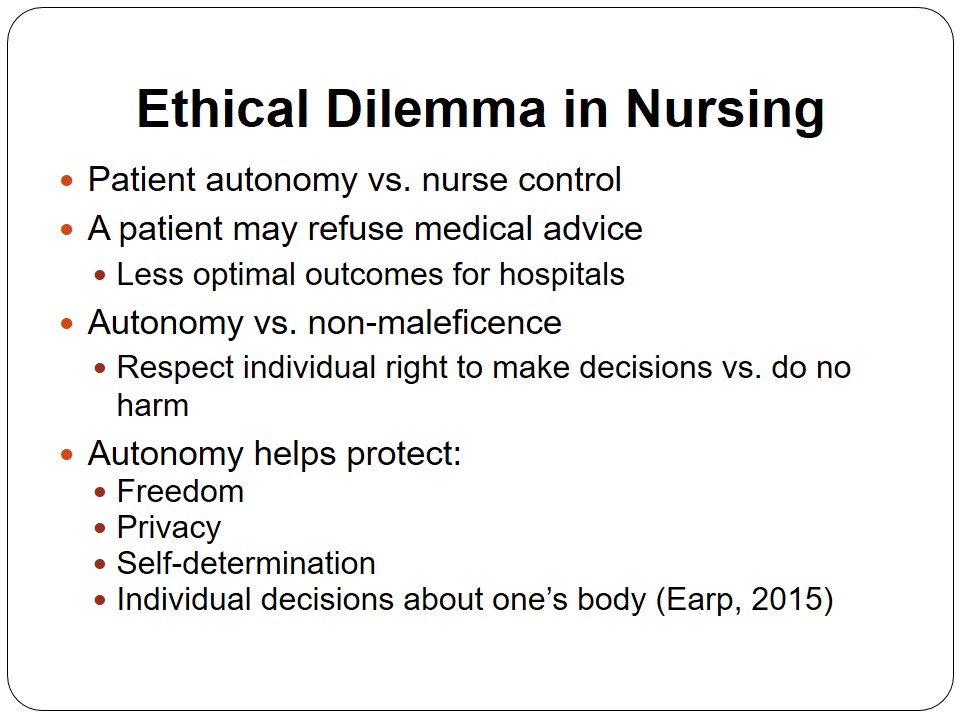
Impact on Patient Care
- Avoiding harm – inessential interventions.
- Patient autonomy – involve him/her in clinical decisions.
- Privacy – patient medical records.
- Prioritize patient/family beliefs, values & interests –patient-centered care.
- Adequate, informed consent – valid.
- Less harmful or painful treatments.
Learning how to navigate through ethical dilemmas may result in optimal care. Ethical dilemmas may alter my approach to patient care. I would avoid interventions that cause pain or harm, including MC without anesthetics, as they are in conflict with the principle of non-maleficence. With regard to patient autonomy, I think involvement can help balance between safety and self-determination. Additionally, I would promote privacy of information and prioritize patient/family interests in line with the principles of patient-centered care.
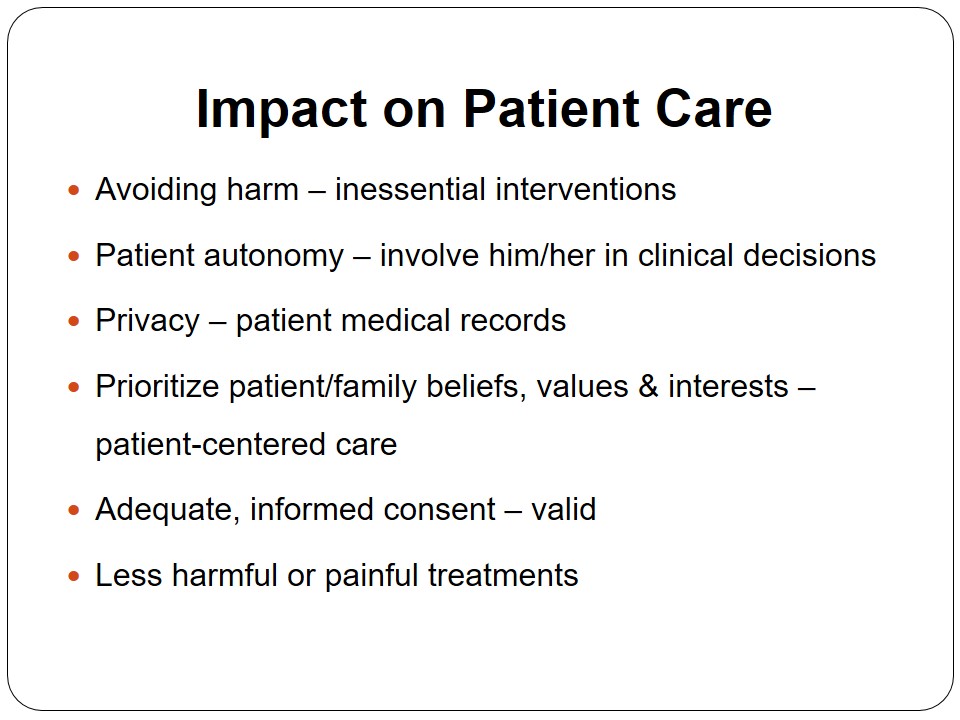
Conclusion
- MC without anesthetics:
- Not medically justified – sensitivity to pain by neonates.
- Not ethically justified – pain > pleasure (no utility).
- Pros vs. cons:
- Disease prevention, e.g., STIs (weak evidence).
- Inconsistent with basic ethical principles.
- Conflicts medical ethics:
- Minimized through local anesthetics & less painful procedures.
- Common ethical dilemma: patient autonomy vs. nurse control.
MC without pain relief has no medical or ethical justification, as evidence suggests that neonates do feel pain (Morris, 2016). From a utilitarian perspective, the pain endured means that maximum happiness cannot be experienced. Further, the cons of MC exceed the pros. To avoid conflicting medical ethics, local anesthetics should be used to minimize pain/trauma. Patient involvement through informed consent can allow a nurse to balance between autonomy and nurse control in practice.
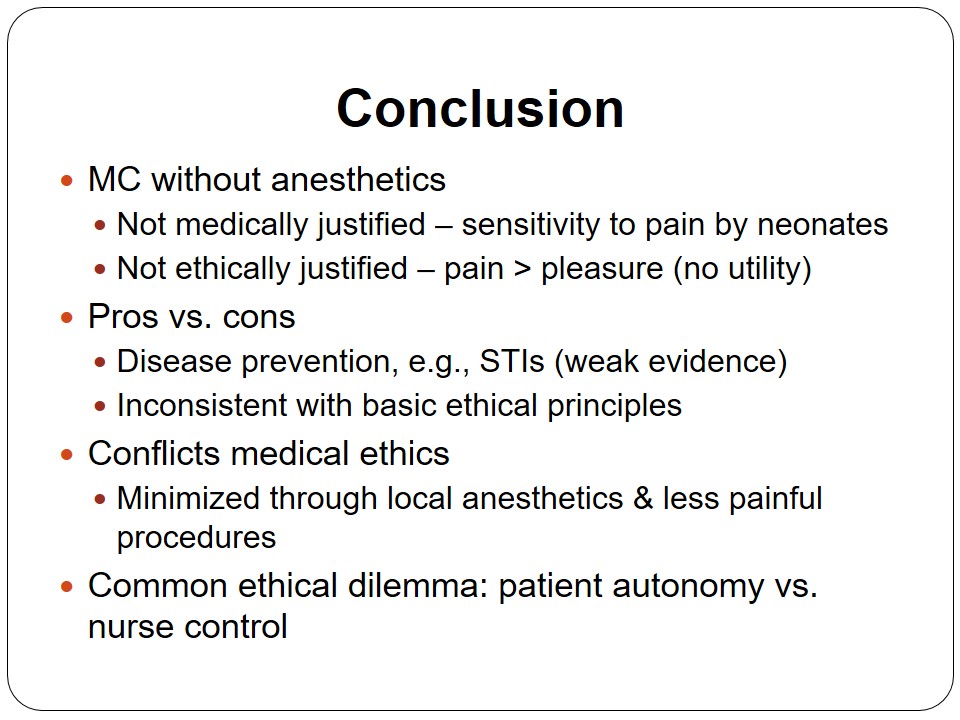
References
Alkhenizan, A., & Elabd, K. (2016). Non-therapeutic infant male circumcision. Saudi Medical Journal, 37(9), 941-947. Web.
Bellieni, C. V., Alagna, M. G., & Buonocore, G. (2013). Analgesia for infants’ circumcision. Italian Journal of Pediatrics, 13(1), 39:38. Web.
CDC. (2014). Draft CDCrecommendations for providers counseling male patients and parents regarding male circumcision and the prevention of HIV infection STIs, and other health outcomes. Web.
Earp, B. D. (2015). Do the benefits of male circumcision outweigh the risks? A critique of the proposed CDC guidelines. Frontiers in Pediatrics, 18(1), 1-6. Web.
Mondal, J., Ponnambath, D. K., & Parija, S. C. (2016). Utilitarian and deontological ethics in medicine. Tropical Parasitology, 6(1), 5-7. Web.
Morris, B. J. (2016). Circumcision and Anesthesia. Web.
Morris, B. J., & Kriegler, J. N. (2017). Penile inflammatory skin disorders and the preventive role of circumcision. International Journal of Preventive Medicine, 8(1), 32-38. Web.
Morris, B. J., Krieger, J. N., & Klausner, J. D. (2017). CDC’s male circumcision recommendations represent a key public health measure. Global Health: Science and Practice, 5(1), 15-27. Web.
Simforoosh, N., Tabibi, A., Khalili, S. A., Soltani, M. H., Afjehi, A., Aalami, F., & Bodoohi, H. (2012). Neonatal circumcision reduces the incidence of asymptomatic urinary tract infection: a large prospective study with long-term follow up using Plastibell. Journal of Pediatric Urology, 8, 320–323. Web.
Svoboda, J. S., & Van Howe, R. S. (2013). Out of step: Fatal flaws in the latest AAP policy report on neonatal circumcision. Journal of Medical Ethics, 39(7), 434–441. Web.
Tobian, A. R., Kacker, S., & Quinn, T. C. (2013). Male circumcision: A globally relevant but underutilized method for the prevention of HIV and other sexually transmitted infections. Annual Review of Medicine, 65(1), 293-306. Web.